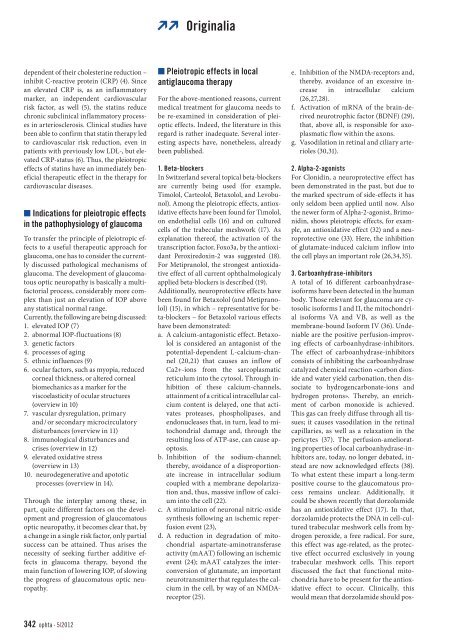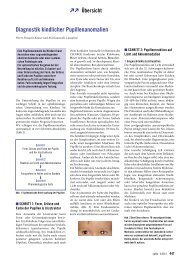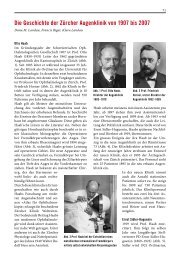Ausgabe 5/2012 - ophta
Ausgabe 5/2012 - ophta
Ausgabe 5/2012 - ophta
Erfolgreiche ePaper selbst erstellen
Machen Sie aus Ihren PDF Publikationen ein blätterbares Flipbook mit unserer einzigartigen Google optimierten e-Paper Software.
Originaliadependent of their cholesterine reduction –inhibit C-reactive protein (CRP) (4). Sincean elevated CRP is, as an inflammatorymarker, an independent cardiovascularrisk factor, as well (5), the statins reducechronic subclinical inflammatory processesin arteriosclerosis. Clinical studies havebeen able to confirm that statin therapy ledto cardiovascular risk reduction, even inpatients with previously low LDL-, but elevatedCRP-status (6). Thus, the pleiotropiceffects of statins have an immediately beneficialtherapeutic effect in the therapy forcardiovascular diseases.■ Indications for pleiotropic effectsin the pathophysiology of glaucomaTo transfer the principle of pleiotropic effectsto a useful therapeutic approach forglaucoma, one has to consider the currentlydiscussed pathological mechanisms ofglaucoma. The development of glaucomatousoptic neuropathy is basically a multifactorialprocess, considerably more complexthan just an elevation of IOP aboveany statistical normal range.Currently, the following are being discussed:1. elevated IOP (7)2. abnormal IOP-fluctuations (8)3. genetic factors4. processes of aging5. ethnic influences (9)6. ocular factors, such as myopia, reducedcorneal thickness, or altered cornealbiomechanics as a marker for theviscoelasticity of ocular structures(overview in 10)7. vascular dysregulation, primaryand / or secondary microcirculatorydisturbances (overview in 11)8. immunological disturbances andcrises (overview in 12)9. elevated oxidative stress(overview in 13)10. neurodegenerative and apototicprocesses (overview in 14).Through the interplay among these, inpart, quite different factors on the developmentand progression of glaucomatousoptic neuropathy, it becomes clear that, bya change in a single risk factor, only partialsuccess can be attained. Thus arises thenecessity of seeking further additive effectsin glaucoma therapy, beyond themain function of lowering IOP, of slowingthe progress of glaucomatous optic neuropathy.■ Pleiotropic effects in localantiglaucoma therapyFor the above-mentioned reasons, currentmedical treatment for glaucoma needs tobe re-examined in consideration of pleiopticeffects. Indeed, the literature in thisregard is rather inadequate. Several interestingaspects have, nonetheless, alreadybeen published.1. Beta-blockersIn Switzerland several topical beta-blockersare currently being used (for example,Timolol, Carteolol, Betaxolol, and Levobunol).Among the pleiotropic effects, antioxidativeeffects have been found for Timolol,on endothelial cells (16) and on culturedcells of the trabecular meshwork (17). Asexplanation thereof, the activation of thetranscription factor, Foxo3a, by the antioxidantPeroxiredoxin-2 was suggested (18).For Metipranolol, the strongest antioxidativeeffect of all current ophthalmologicalyapplied beta-blockers is described (19).Additionally, neuroprotective effects havebeen found for Betaxolol (and Metipranolol)(15), in which – representative for beta-blockers– for Betaxolol various effectshave been demonstrated:a. A calcium-antagonistic effect. Betaxololis considered an antagonist of thepotential-dependent L-calcium-channel(20,21) that causes an inflow ofCa2+-ions from the sarcoplasmaticreticulum into the cytosol. Through inhibitionof these calcium-channels,attainment of a critical intracellular calciumcontent is delayed, one that activatesproteases, phospholipases, andendonucleases that, in turn, lead to mitochondrialdamage and, through theresulting loss of ATP-ase, can cause apoptosis.b. Inhibition of the sodium-channel;thereby, avoidance of a disproportionateincrease in intracellular sodiumcoupled with a membrane depolarizationand, thus, massive inflow of calciuminto the cell (22).c. A stimulation of neuronal nitric-oxidesynthesis following an ischemic reperfusionevent (23),d. A reduction in degradation of mitochondrialaspartate-aminotransferaseactivity (mAAT) following an ischemicevent (24); mAAT catalyzes the interconversionof glutamate, an importantneurotransmitter that regulates the calciumin the cell, by way of an NMDAreceptor(25).e. Inhibition of the NMDA-receptors and,thereby, avoidance of an excessive increasein intracellular calcium(26,27,28).f. Activation of mRNA of the brain-derivedneurotrophic factor (BDNF) (29),that, above all, is responsible for axoplasmaticflow within the axons.g. Vasodilation in retinal and ciliary arterioles(30,31).2. Alpha-2-agonistsFor Clonidin, a neuroprotective effect hasbeen demonstrated in the past, but due tothe marked spectrum of side-effects it hasonly seldom been applied until now. Alsothe newer form of Alpha-2-agonist, Brimonidin,shows pleiotropic effects, for example,an antioxidative effect (32) and a neuroprotectiveone (33). Here, the inhibitionof glutamate-induced calcium inflow intothe cell plays an important role (26,34,35).3. Carboanhydrase-inhibitorsA total of 16 different carboanhydraseisoformshave been detected in the humanbody. Those relevant for glaucoma are cytosolicisoforms I and II, the mitochondrialisoforms VA and VB, as well as themembrane-bound Isoform IV (36). Undeniableare the positive perfusion-improvingeffects of carboanhydrase-inhibitors.The effect of carboanhydrase-inhibitorsconsists of inhibiting the carboanhydrasecatalyzed chemical reaction «carbon dioxideand water yield carbonation, then dissociateto hydrogencarbonate-ions andhydrogen protons». Thereby, an enrichmentof carbon monoxide is achieved.This gas can freely diffuse through all tissues;it causes vasodilation in the retinalcapillaries, as well as a relaxation in thepericytes (37). The perfusion-amelioratingproperties of local carboanhydrase-inhibitorsare, today, no longer debated, insteadare now acknowledged effects (38).To what extent these impart a long-termpositive course to the glaucomatous processremains unclear. Additionally, itcould be shown recently that dorzolamidehas an antioxidative effect (17). In that,dorzolamide protects the DNA in cell-culturedtrabecular meshwork cells from hydrogenperoxide, a free radical. For sure,this effect was age-related, as the protectiveeffect occurred exclusively in youngtrabecular meshwork cells. This reportdiscussed the fact that functional mitochondriahave to be present for the antioxidativeeffect to occur. Clinically, thiswould mean that dorzolamide should pos-342 <strong>ophta</strong> • 5|<strong>2012</strong>












